Introduction
“Heritage” is a word of many meanings, tied to the category of objects it refers to or more directly to its owner: we have “cultural”, “historical”, “folkloric”, “familial”, “national”, “international”, “tangible” and “intangible” heritage. Despite the varying semantics, they all represent a set of values transmitted from one generation to the next. The origin for our modern notion of heritage, or patrimony, can be traced to the Latin term patrimonium, which evokes the interlinked notions of inheritance – items passed down by the father (pater) – and that of bequeathing for the use of one’s descendants.
A lengthy activity as a researcher and university professor, which has seen me maintain contact with people from different regions, has shown me that – for most – the concept of patrimony or heritage is an abstraction, a descriptive account of items, values and beauties without a clearly-defined owner to exercise both rights and responsibilities over them. In this regard, the notion best ingrained in our societal consciousness is that of the common heritage of humanity (or “world” heritage”), which brings together sites of exceptional historical and cultural importance with natural treasures of notable interest by virtue of their signification and their aesthetic attractiveness. UNESCO played an important role in launching and popularizing the concept of a geopark. From a judicial perspective, one legal field currently seeing a rapid expansion and engagement from specialists across the globe is the right to cultural and natural heritage, which attempts to establish a robust judicial framework which proves consistent in its protection and conservation of heritage values.
There have already been several Directives from the European Union in this regard, tied to migratory species, to wild flora and fauna, to natural habitats, to architectural heritage, etc.
Without having formally set out to contribute to the development of this legislative framework, the creation of UNESCO geoparks, which began 20 years ago, gave rise to a concrete notion of regional heritage in terms of property, its preservation and its valorization. Within a UNESCO geopark, heritage and human community constitute the fundamental pillars of sustainable construction and development. Here, heritage is approached conceptually and in an applied manner in its integrity, both as natural values (biological and geological) as well as through historical and cultural lenses. Through this approach, both nature and culture are allowed to show their interlinks and reciprocal significances: the cultural values of nature as the source of inspiration in arts, architecture, customs, and folklore traditions. Such an understanding of heritage elements, either natural, cultural, or architectural allows, above all, for a solid grasp of their importance and of the risks that menace them. This, in turn, determines the likelihood of protection and conservation efforts within the community.
This approach to natural heritage employed by geoparks confers a certain consistency to the concepts of ownership, rights and obligations required in the keeping or use of heritage so as to be of further use to later generations as well. The owners of geological heritage are the local people themselves, represented through those designated to manage the geoparks. Their patterns of action and engagement can lead to the desired outcome of sustainable regional development – the goal of any UNESCO geopark.
Yet also specific to geoparks is the holistic treatment of the two parts of nature: the inanimate mineral component, or geodiversity, and the biological component, or biodiversity. The importance of such a holistic research approach to nature stems from the fact that it concurrently highlights geodiversity’s role as the support for life as well as showcasing the causal relations and interdependency between geological and biological processes, thereby offering us a better understanding of nature and of the scale of threats it currently faces, with real consequences seen in conservation measures and initiatives.
The geopark is the organizational and managerial framework in which phenomena from the geological past, such as the formation of continents, evolution of life forms, volcanism, climate change, etc. are depicted for the public at large. The attractive and often interactive presentation and interpretation of past events, which is a hallmark of geopark practice, efficiently contributes to geoeducation, supports the public’s understanding of the need for geoconservation and underpins the development of geotourism. In their high achievement of the three above components of the geodiversity paradigm, managers, and scientific researchers within UNESCO geoparks collaborate closely in promoting the Life and the Earth Sciences together.
In a geopark, geoconservation is closely intertwined with geoeducation and geotourism. Geoparks are planned out and developed as natural laboratories, in which objects and natural phenomena – not always easy to understand – are explained to students and the broader public. As stipulated by UNESCO’s original criteria for constitution, “a geopark represents a special site to promote environmental education, one that promotes pedagogical and methodological innovation, research in the geosciences and the development of an interdisciplinary relationship between the Life and Earth Sciences, as well as between the two and other disciplines involved in the study of the history and cultural heritage of a region” (Patzak & Eder 1998). In a geopark, the scientific and educational importance of heritage brings positive gains to local communities through tourism. All geoparks feature guided walks which alternate natural landmarks, geological sites, biological sites, and places of historical significance. Over the course of a single such route, one can witness sites of specific plant and animal species in the region, or various aspects of the history of the Earth: rocks, minerals, fossils, tectonic and sedimentary structures, all explained to the public by the guides and informative panels.
Fossils in the European UNESCO Geopark Network
Fossils – the central theme of this volume – are one of the main components of natural heritage. Through the information, they offer on our biological past, through the novelty of old forms unknown to present eyes such as trilobites, ammonites, ichthyosaurs, and dinosaurs, through the information contained concerning biological revolutions and extinction events of the past and, ultimately, by the wondrous stories that surround them, fossils are, undoubtedly of exceptional interest to the public at large.
Fossils have reconstructed the 4-billion-year history of life on Earth, from the earliest cellular structures endowed with features of life to the “intelligent human” (Homo sapiens). The stages of this history are marked by the fossil record, the entire calendar of the Earth history is predicated upon the evolutionary succession of fossils (Fig. 1). At the same time, fossils are an indicator of the environments in the geological past and play a key role in reconstructing the particular aspects of the shifting geographies that marked the surface of the Earth throughout its history: climatic changes, the differing proportions of landmass versus seas, and their consequences for entire ecosystems.
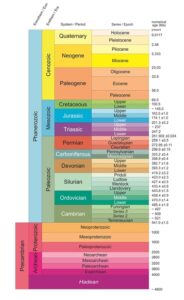
Figure 1. Geological time scale (source Geological Survey Ireland).
This special volume of Geoconservation Research dedicated to the Palaeontological Heritage and Geoconservation in European UNESCO Geoparks contains 60 articles penned by authors active in 35 geoparks who responded to my invitation, as the coordinator of the thematic Fossils group within the European Geopark Network. The articles present a series of paleontological themes representative of Europe’s different regions, the ways in which fossils are employed in scientific education, in the mapping of touristic routes of interest, and in the protection of fossiliferous sites. The articles are grouped in chronostratigraphic order, from the oldest to the most recent fossil records and events; together, they convey vivid images of the geobiological history of Europe, from the Precambrian to the Paleolithic. As presented in this volume, this history begins in the northern Scottish Highlands, where the earliest vestiges of life were found dating from well over 1 billion years ago and ends with the cave networks of Germany and Spain, where remains of modern humans were found alongside their artistic creations.
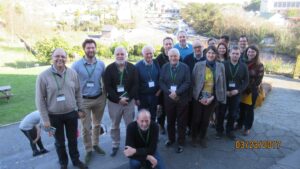
Figure 2. Members of the thematic group ‘Fossils’in the European Geoparks Network, in March 2017. In front, from left to right: Artur Sá, Jakob Hansen, Jose Maria Barera, Tony Ramsay, Dan Grigorescu, Alicia Serna, Vaclav Mencl, Christiane Stolz. Second row: Timo Kluttig, Zelmer Henning, Marco Firpo, Darja Komar, Siegfried Roth (face hidden), Oliver Gulas. Squatting in front: Alberto Gil Toja.
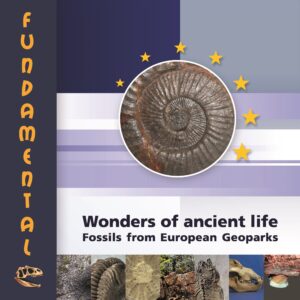
Figure 3. Cover of the illustrated album Wonders of the ancient life. Fossils from European Geoparks (2014) - the first public achievement of the Thematic group Fossils in the European Geoparks Network.
At the book’s origin lies the activity of the Fossils thematic group of the European Geopark Network (Fig. 2). One of the early achievements of the group was the album Wonders of ancient life – Fossils from European Geoparks (Alcala & Mampel 2014) (Fig. 3). Over the following years, the activity of the group focused on highlighting the fossil record and key events of the history of life, in geohistorical succession. The result was the poster exhibition titled Images of ancient lives in the UNESCO European Geoparks, presented during the international reunion of European geopark representatives in Aalen, Germany (March 2019) and the UNESCO Conference in Seville (September 2019) (Fig. 4).
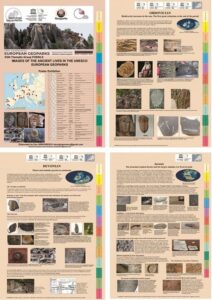
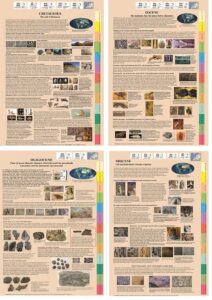
Figure 4. Selected posters in the exhibition Images of the ancient lives in the UNESCO European Geoparks, presented in Aalen (Germany, March 2019) and Seville (Spain, September 2019).
In a harmonious interplay, the articles present fossils that are most representative of the heritage of the particular geoparks from which they come, with due attention given to their scientific and cultural significance as well as their importance in supporting educational activities and tourism. Moreover, the articles also document the geoconservation measures employed in preserving these representative fossils, as well as some of the difficulties encountered in this endeavor.
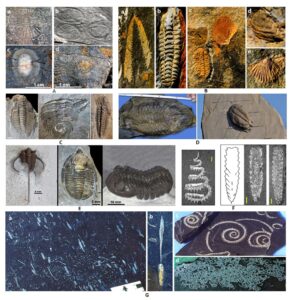
Figure 5. Paleozoic animals. A) Cambrian fossils in Sierra Norte de Seville geopark. a,b- soft body jellyfishes imprints. c,d- archaeocyathids –the first reef builder animals (cross sections). B) Ordovician. Naturtejo geopark. a-graptolite. b-trilobite. c - trilobite and brachiopod. d- bivalve. e-brachiopod. C) Cambrian trilobites. Sierra Norte de Seville geopark. D) Ordovican. Arouca geopark. Giant trilobite (c.1 m length). Right-The giant trilobites are the town-symbol of Arouca. E) Devonian. Vulkaneifel geopark. Exceptionally preserved trilobites. F) Silurian. Sierra Norte de Seville geopark. Graptolites. G) Silurian. Molina- Alto Tajo geopark. Graptolites. a- current oriented rhabdosomes. b- rhabdosome with a large extrathecal structure. c- twisted rhabdosomes. d- twisted rhabdosomes clustered by currents.
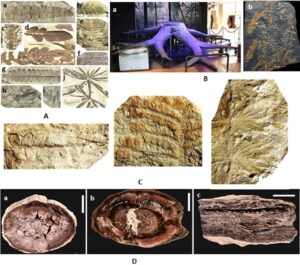
Figure 6. Paleozoic flora. A) Carboniferous. Sierra Norte de Sevilla geopark .a-h -. “Seed ferns “(Ptereidospermatophytes), i,j- Annularia –leaves of the plant Calamites. B) Carboniferous. TERRA Vita geopark. a- Root and stem of Sigillaria, a lycopodiophyte plant related to the club-mosses. b - Sphenophyllum related to the horsetail plants, branches with leaves. C) Permian. Molina-Alto Tajo. a,b- “Seed ferns “(Ptereidospermatophytes). c- Annularia –leaves of Calamites. D) Carboniferous and Permian. Bohemian Paradise geopark. a,b- Cross sections of fossil woods. c- Polished section of silicified chert with plant fragments.
The chapters of the volume, corresponding to the great stratigraphic divisions: Precambrian, Paleozoic, Mesozoic and Cenozoic and their respective primary subdivisions, present the fossil record both in situ, within geosites, as well as in the form of museum exhibits. In this way, the paleontological symbols of the different geological ages: jellyfish and archaeocyathids in the Cambrian, graptolites in the Ordovician and Silurian, trilobites in all periods of the Paleozoic, vascular cryptograms and primitive gymnosperms in the Carboniferous and the Permian (Figs. 5 and 6 ), ammonites, belemnites, inoceramids and other bivalves, ichthyosaurs and dinosaurs – in the Mesozoic (Fig. 7), corals, bivalves, gastropods and mammals in the Cenozoic (Fig. 8).
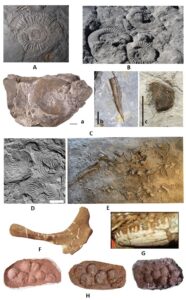
Figure 7. Mesozoic. A) Jurassic. Swabian Alb geopark. Ammonite. B) Jurassic Haute Provence geopark. Detail of the Dalle aux ammonites that include remains of more than 1500 individuals. C) Cretaceous. Karavanke / Karawanken geopark. a- ammonite. b- belemnite. c- aptychus. D) Jurassic. Swabian Alb geopark. Posidonya (bivalve). E) Jurassic. Monts Ardeche geopark. Marine crocodile, skeletal remains. F) Cretaceous. Maestrazgo geopark. Dinosaur bone (ischium). G) Cretaceous. Hateg country dinosaurs geopark. Lizard dentary. H) Cretaceous. Hateg country dinosaurs geopark. Dinosaur eggs clutches.
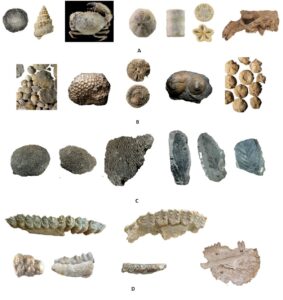
Figure 8. Cenozoic. A) Eocene. Sobrarbe. From left to right: nummulite, gastropod, decapod crustacean, echinoid theca, crinoid - stem fragment, crinoid ossicles -cross section, sirenid skull. B) Eocene. Central Catalunya geopark. From left to right: nummulites, colonial and solitary corals, gastropod, echinoids (sea-urchins). C) Oligocene. Beigua geopark. Colonial corals and angiosperm plants leaves. D) Miocene. Molina-Alto Tajo. Upper row: Hipparion mandible and maxilla teeth. Lower row: Hippopotamodon lower molar, bovid Tragoportax mandible fragment (in lateral and occlusal views).
One particular attraction to the broader public, as well as a great joy for paleontologists, are the so-called “miracles of conservation”: fossils that preserve the most minute details of their anatomy: the colors of flowers and insects, the ribbing of insects’ wings, the skin textures and the completely preserved skeletons of vertebrates, with all elements in articulation. Such cases, known as lagerstätten (from German – “deposition space”) depend on highly particular fossilization conditions: an anoxic environment, bereft of oxygen and scavengers, which constitute the primary destructive factors in the fossilization process. Within the volume, lagerstätten are recorded from the Permian, in the TERRA vita geopark, from the Jurassic, in the Swabian Alb geopark, from the Eocene in Messel Pit (a site also on the World Heritage List), in Germany. Other notable lagerstätten records come from the Eocene and Oligocene in the Causses du Quercy geopark and from the Oligocene in the Luberon geopark, both in France. (Fig. 9).
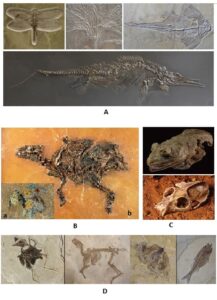
Figure 9. “Miracles of preservation”. A) Jurassic. Swabian Alb geopark: insects, crinoids, thornback ray, ichthyosaur (all from the Holzmaden private quarry). B) Eocene. Messel Pit: beetle with a small flower preserved on one wing-cover (a), primitive horse (b). C) Eocene-Oligocene. Causses du Quercy geopark: mummy frog (above), carnivorous mammal (below). D) Luberon geopark: Passeriformes bird, ruminant mammal, butterfly, teleost fish.
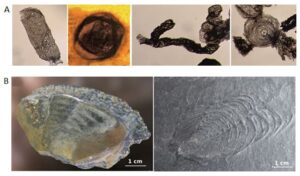
Figure 10. Fossils preserved in metamorphic rocks: A) Precambrian microfossils , among the oldest in Europe in North-Western Highlands geopark. B) Ordovician fragmented and deformed trilobites in Courel Mountains geopark
At the opposite end of the spectrum are poorly conserved fossils, resulting from either unfavorable conditions during fossilization or transformations during diagenetic and metamorphic processes that occurred after deposition. These fossils are all the more interesting for paleontologists, because they can reveal indications of life in conditions hostile to conservation, even though the research is more difficult. Some examples from this category are the organic-walled microfossils of the Precambrian rocks in the North-West Highlands geopark, which are among the oldest evidence of life in Europe and the oldest vestiges of eukaryotic non-marine life in the world (Fig. 10 A). Fossils preserved in metamorphic rocks can also be found from the early Paleozoic in the Courel Mountains geopark in Spain (Fig. 10 B). Another subtle field of paleontological research is the study of trace fossils, marks left by ancient organisms during their lives: trails, burrows, and footprints, all indicative of a creature’s way of life. This is the field of paleoichnology (“the science of trace fossils”), which relies on observations of modern animals to understand traces made by extinct animals. A selection of fossil traces and footprints, of either known or problematic origin, presented in the articles, are shown in Fig. 11. Among the enigmatic traces, are those from the Ediacaran-Cambrian transition in the Villuercas-Ibores-Jara geopark in Spain (Fig. 11 A) and the Daedalus worm-shaped structures from the Ordovician of the same geopark, but also in the Naturtejo geopark in Portugal (Fig. 11 B). Further examples are the Cruziana traces in both these geoparks, produced by crawling trilobites (Fig. 11C). The steps of dinosaurs were imprinted in Triassic sediments in the Monts Ardeche geopark in France, Late Jurassic rocks in the TERRA vita geopark (Fig.11 D) and Early Cretaceous ones in the Maestrazgo geopark in Spain (Fig. 11 E). Bird and mammal tracks are also recorded from Cenozoic sites, in the Oligocene of the Luberon geopark in France (Fig. 11 F) and the Miocene in the cross-border geopark between Hungary and Slovakia, Novohrad-Nograd (Fig. 11 G).
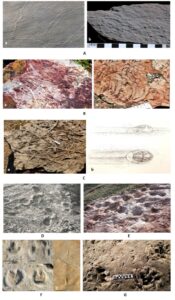
Figure 11. Traces, marks and foot-prints. A) Ediacaran-Cambrian transition. Villuercas-Ibores-Jara geopark. a-Simple horizontal trace fossils, approx. 2 mm wide. b- probe-like branching trace fossil. B) Ordovician. Villuercas-Ibores-Jara and Naturtejo geoparks. a, b- dense burrows left in the substrate by an enigmatic benthic dweller, named Daedalus. C) Ordovician. Villuercas-Ibores-Jara and Naturtejo geoparks. Cruziana- trace-marks (a) left by the trilobites crawling (b). D) Jurassic. TERRA vita geopark. Sauropod dinosaur trackways. E) Cretaceous. Maestrazgo geopark. Ornithopod dinosaur trackways. F) Oligocene. Luberon geopark. Mammal (a) and bird tracks (b). G) Miocene. Novohrad-Nograd geopark. Mammal and bird tracks
Most often, information on life in the past and on the ensemble of associated phenomena and events are best conveyed by exposed fossils found in escarpments and outcrops. One case, described in the volume, is from the Hondsrug geopark in the Netherlands, where, apart from the remains of some Quaternary mammals, nothing can be found on the surface. However, fossils of many groups of animals were found in erratic blocks transported by glaciers. Such “hidden fossils” offer an excellent opportunity for paleontological and geological education, which this geopark, in particular, has tackled with true originality (Fig. 12).
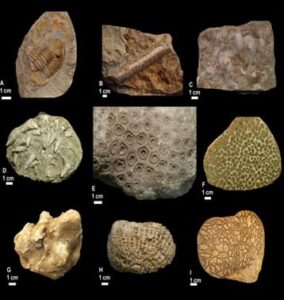
Figure 12. “Hidden fossils. Hondsrug geopark. Ordovician and Silurian fossils found in the glacial erratic blocks: trilobites, nautiloids, brachiopods, solitary and colonial rugose corals, tabulate corals.
Artistic reconstructions of the ancient ecosystems are commonly practiced in the geoparks. They represent an attractive way of interpreting the aspects of life evolution, much appreciated by visitors (Fig. 13).

Figure 13. Artist reconstruction of the terrestrial (marsh) and near-shore ecosystems in the Oligocene of Beigua geopark. (drawn by F. Boccardo).
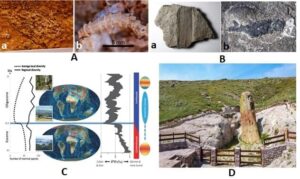
Figure 14. Phenomena and events depicted by fossils. A) Biomineralization processes at the Ediacaran - Cambrian transition, due to which the fossils number and diversity increased tremendously in Cambrian. a- Cloudina, a primitive organic structure with hard skeleton. b Cloudina (detail). Villuercas -Ibores-Jara geopark. B) Remains of the earliest dryland plants and freshwater fish show the beginning of the life on continents. Devonian. Shetland geopark. C) La Grande coupure (“The Great Break”) – episode of mass extinction at the boundary between the Eocene and the Oligocene, followed by great changes in both, marine and terrestrial ecosystems. Causses du Quercy geopark. D) The great Miocene Volcanic eruptions covered with ashes of entire forests whose petrified trees can be seen in different regions of Europe. Lesbos geopark
The articles contained in the present volume showcase a series of phenomena and events that have accompanied the evolution of life, well-illustrated in European geoparks. Of special scientific importance are those depicted in Fig. 14:
- The beginning of the process of mineralization, from the transitional period between the Ediacaran and the Cambrian, which favored the conservation of organic remains and an extraordinary expansion in biodiversity, best illustrated by the fossil Cloudina in the Villuercas-Ibores-Jara geopark (Fig. 14 A)
- The beginnings of complex life in continental environments: remains of the earliest land plants and freshwater fish, found in the Shetland geopark, United Kingdom (Fig. 14 B).
- La Grande coupure (“The Great Break”) - the geological moment of a mass extinction at the boundary between the Eocene and the Oligocene (33.5 million years ago), driven by a powerful glaciation event that caused enormous changes to both land and water species. This episode is particularly well captured in the Causses du Quercy geopark in France (Fig. 14 C).
- The Late Oligocene Warming Event – illustrated by the terrestrial flora found in the Beigua geopark in Italy.
- Volcanic eruptions and their role in the creation of “petrified forests” from the Carboniferous and Permian, found in the Bohemian Paradise geopark in the Czech Republic, the Molina-Alto Tajo geopark in Spain, the Miocene geopark in Lesbos – Greece, (Fig. 14 D). and the Novohrad-Nograd geopark between Hungary and Slovakia
The role of fossils in stratigraphic dating is illustrated by most articles included in the volume. Some articles describe stratigraphic sections that, by their fossil content, are significant for different episodes or events in life history, being designated as localities of international reference, or stratotypes. These include:
- The Valle-syncline in the Sierra Norte de Sevilla geopark, a nearly complete Silurian section that includes most of the standard graptolite biozones of the Silurian System.
- The Global Boundary Stratotype Section and Point (GSSP) of the Aalenian Stage at Fuenteslaz in the Molina-Alto Tajo geopark, showcasing the base of the Middle Jurassic (Fig. 15 a).
- The La Tuilièresite in the Luberon geopark in France, one of the most fossiliferous outcrops in the historical stratotypical region of the Lower Cretaceous Aptian stage (Fig. 15 b).
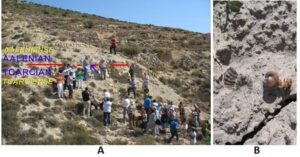
Figure 15. Internationally significant stratigraphic sections in European UNESCO geoparks. A) Fuenteslaz section in the Molina-Alto Tajo geopark, is designated Global Boundary Stratotype Section and Point for g the base of the Middle Jurassic. B) Fossiliferous outcrop in the historical stratotypical region of the Lower Cretaceous Aptian stage. Luberom geoparc.
Geoeducation, Geotourism, Geoconservation
UNESCO geoparks represent laboratories in nature, where the natural world of the geological past, with its local and regional details, is presented to children, pupils and students with an emphasis on the wider significance and the interconnections between many parts of the world, thus cultivating a better understanding of the dangers that threaten nature and its need for active protection. Schools in the areas of geoparks with a rich paleontological heritage often organize open lessons there, while universities bring their students out to research and interpret the significance of fossiliferous sites (Fig. 16).
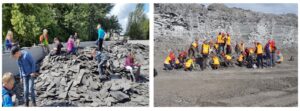
Figure 16. Children are guided to search for fossils while the university students observe and interpret the origin of the black slates in a private quarry. Swabian Alb geopark.
The geoparks employ a broad variety of methods and solutions to develop geoeducation and geotourism. Scientific explanations of the geological phenomena and geobiological events, made as attractive and accessible to the public as possible, are presented through informative panels or information kiosks housed within the fossiliferous sites themselves (Fig. 17 A,B). Sometimes, even small museums have been organized in situ, in places bearing animal footprints and tracks (Fig. 17 C,D). Fossils are the key strengths of these geoparks because they generate scientific interest and often have aesthetic appeal for the public. Of the 80 European geoparks, half boast an impressive paleontological heritage, capitalized upon both touristically and scientifically; nearly half have contributed to the articles contained in the present volume. Paleontological parks, open-air museums, and tourist trails dedicated to fossils are organized by several European geoparks, such as Naturtejo and Arouca in Protugal, Maestrazgo, Origene, Sobrarbe, Sierra Norte de Seville, Villuercas-Ibores-Jara in Spain, Luberon, Causses du Quercy, Haute-Provence in France, TERRA Vita, Vulkaneifel, Bergstrasse-Odenwald in Germany, the Novohrad-Nograd cross-border geopark between Hungary and Slovakia, the Hațeg Country Dinosaur Geopark in Romania, and the Lesbos Geopark in Greece. Geoparks are institutions which, for both their proper functioning and in support of regional development, call for partnerships and collaborations, on the one hand between the geopark managers and regional stakeholders, and on the other, with scientific and cultural institutions, non-governmental organizations. To enhance the paleontological heritage, agreements were reached in most cases with the owners of the quarries, museums and private paleontological collections. The articles included in this volume have reinforced the geoparks collaboration with researchers in institutions and universities far beyond the geoparks themselves: many articles are co-authored by such researchers and geopark managers, which further reinforces the consistency and scientific weight of the volume. The local communities in and around geoparks are likewise encouraged to promote local products: foodstuffs, weaving or artisanal crafts, which are then commercialized bearing the geopark branding (Fig. 17 E).
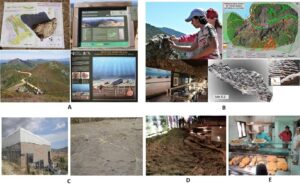
Figure 17. Geoeducation and geoturism. A) Fossils as eduational resources in Villuercas-Ibores-Jara geopark: guided tours, explanatory and interpretative panels on the marine life and bottom-dwellers during Ordovician. B) Penha Garcia Ichnology Park in Naturtejo Geopark offers also educational programs on fossils focused on the fossil traces interpretation. C) The dinosaur foot prints museum on the fossiliferous site in Maestrazgo geopark with detail of the indoor exposure. D) Visitors at the sheltered excavation on Miocene mammals and bird foot prints in Nohrad - Novograd geopark. E. Fossils inspired the geo-bakery in Las Loras geopark.

Figure 18. The geosites in a geopark are not sheltered from destructions an illegal digging for fossils. A) Limestone block with ammonites were extracted in Sierras Subbeticas geopark. Photographs before (left) and after (right) the block removal. B) Dinosaur eggs stolen from the site in the Hateg country dinosaurs geopark. Fortunately, the eggs were recuperated.
The result of all this effort is a visible increase in the pride and sense of belonging to theo geopark territories felt by the locals themselves.
Curation and geoconservation play a key role in the UNESCO geoparks in supporting geoeducation and geotourism, and often the activities involve scholars and young people from the geopark itself or from outside. Although the authors were tempted to present the geopark activities in the lightest, they do not shy away from highlighting some negative aspects as well, such as fossil theft (e.g. in Molina-Alto Tajo, Hațeg Country Dinosaur geoparks), or the destruction of sites through unauthorized construction projects (Sierras Subbeticas geopark) (Fig. 18).
In conclusion, the present volume dedicated to the paleontological heritage of European geoparks constitutes an interesting source of scientific information on Europe’s paleobiological past. Grouped by geological ages, the articles provide glimpses on the evolution of life forms in Europe. Well-presented, protected and capitalized upon through the managerial system of UNESCO geoparks, they also represent a collection of specific cases where the fossil record directly supports the dissemination of scientific knowledge, the education of pupils and students, and the development of geotourism with positive impacts on the lives and livelihoods of the local populations. Hopefully, the volume will inspire other thematic groups to present the riches and significances of other kinds of natural and cultural heritage, so important in the UNESCO geoparks.
The principal merit for the editing and publishing of the volume goes to the editorial board of the journal Geoconservation Research, namely to Professor Michael Benton – Editor in Chief, Ms. Mahshid Pezeshki – Executive Manager, Dr. Vachik Hairapetian – Director in Charge, and to all other members of the editorial team. A still-young publication, through this editorial effort Geoconservation Research proves its desire to become an active promoter of the values of geodiversity, and of the experience gained in their conservation and practical application.
Acknowledgments
I am greatly indebted to Mr. Maxim Onofrei for the English translation and to Mr. Ion Scutelnicu for the illustration arrangement. Special thanks are addressed to all colleagues in the EGN Thematic Group Fossils and to the other EGN members who expressed appreciation for the work. I appreciate the friendly and fruitful collaboration I have had during the preparation of the book with Professor Michael Benton, editor-in-chief and Ms. Mahshid Pezeshki, executive manager.
Conflict of Interest Declaration. The author declares no conflict of interest in the publication of the article.
References
Alcala I & Mampel I (coord.) (2004). Wonders of ancient life. Fossils from European Geoparks, Fundamental (26, I, pp. 1–166).
